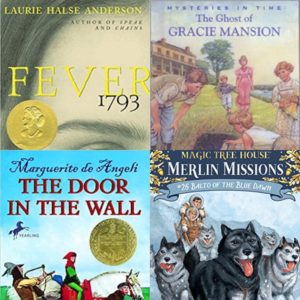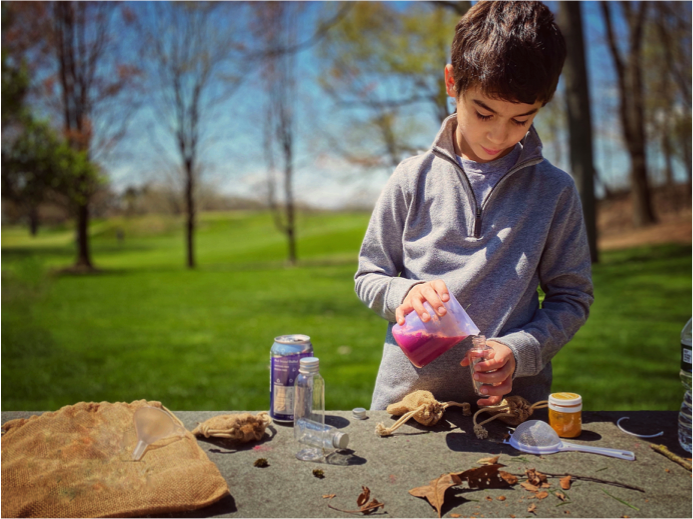By Kelly Bakshi
Looking for something engaging and simple to do outside? Try making a potion. Little apothecaries become absorbed with this easy, open-ended play and pretend activity.
MATERIALS NEEDED:
Ingredient Containers: Small containers of any kind will do for kids to gather up bits of nature for their potions. Snack Tupperware, empty jewelry boxes or match boxes, an empty egg carton, gift sacks, etc.
Ingredients:
From Mother Nature: Invite your potion maker to collect grass, flower petals, acorns, pine needles, leaves, pebbles, herbs, moss, or anything else in nature that looks interesting or smells good. How do the objects feel? What colors can you find in nature? How do the items smell? What happens to the level of smell when items are torn up or mashed with a rock?
From Mother’s Kitchen: Food coloring or turmeric, club soda, or tonic water
Mixing Tools: Anything that allows your potion maker to pour and mix such as measuring cups and spoons, a funnel, a small sieve or tea strainer, and an empty plastic container. Don’t forget stirring sticks of varying sizes. A thin twig for a little swirl or a thick stick to mix a large batch.
Potion Bottles: Empty, clear plastic bottles with lids are best. It’s more fun with varied bottle sizes. Empty water or hand sanitizer bottles work great.
DIRECTIONS:
Play! Choose some ingredients to put in a cup, add some turmeric or food coloring, pour in some fizzy water, and stir, smell, mix, mash, strain, experiment, try again–just don’t drink the potion. Bottle it up, name it, pour it, dump it, sprinkle it, shake it–but don’t drink the potion. Mix a new formula and have fun! Post a picture of your mix master and tag @jayheritagecenter for a chance to be featured!
• • •
FOUR INSPIRING BOOKS FOR KIDS ABOUT PANDEMICS
 By Kelly Bakshi
By Kelly Bakshi
Posted 4/26/20
Some events in history feel so foreign and distant that they could never repeat themselves–until they do. Unfortunately, waves of epidemics have resurfaced through out the centuries, but so, too, have resilience, ingenuity and humanity. From the bubonic plague to influenza, people heal and even thrive in the wake of an epidemic. These books inspire hope and teach young readers that history sometimes can repeat itself.
Growing Reader
Balto of the Blue Dawn
Magic Tree House Merlin Missions
by Mary Pope Osborn
Jack and Annie’s magic treehouse transports them to Alaska in 1925. They befriend
Balto, a Siberian Husky who needs their help saving people from a diptheria
epidemic. As is the hallmark of the series, this tale is filled with accurate history and
exciting storytelling.
The Ghost of Gracie Mansion
Mysteries in Time Series
by Susan Kohl
Set during the yellow fever epidemic in 1803, the Gracie family retreats from
Manhattan to their new country mansion (which would later serve as the home to New
York’s mayors) seeking safety. While there, the children unravel a mystery and readers
learn about the American Revolution along the way. This book was fact checked for
historical accuracy.
Tween Reader
Door in the Wall
by Marguerite De Angeli
This Newberry Medal winner is set in the Middle Ages during the bubonic plague. Robin,
a son of a nobleman, is expected to become a knight. All of that changes when he loses
the use of his legs due to illness. Robin not only learns to overcome adversity but
discovers that trying his best often leads to surprising (and wonderful) results.
Fever 1793
by Laurie Halse Anderson
Set in Philadelphia during the yellow fever epidemic, fourteen-year-old Mattie Cook
experiences a change in perspective as her family tries to survive. Readers gain
knowledge of the American Revolution and the Free African Society as this story
unfolds.
Kelly Bakshi, MS Ed., is a boy mama, freelance writer, and non-fiction children’s book
author. She is also co-chair of the JHC Children’s Education Committee. Connect with
her on instagram @Kellybakshibooks.
